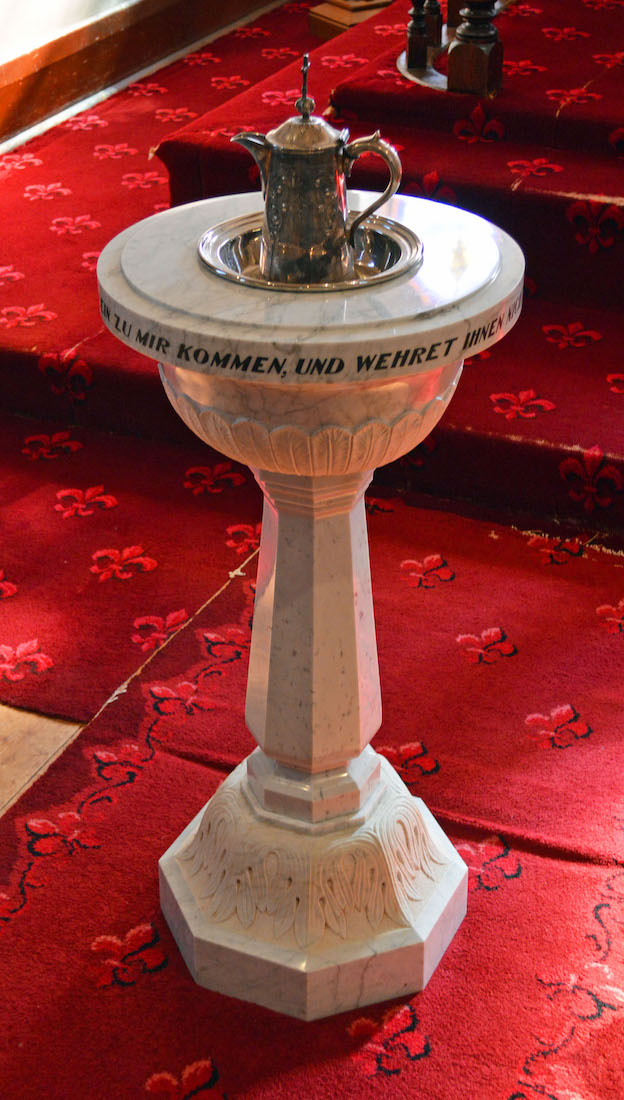
The motifs in the South windows of the nave are from left: • Alpha and Omega (first and last letters of the Greek alphabet, describing Christ – Revelation 1:8); • Lamb with Flag (a symbol of Christ as the Lamb of God); • IHS (an iconograph for Christ – JES in Latinised Greek); • a bunch of grapes – alluding to the Eucharist.
22. NAVE

We now examine the nave from ground level, looking towards the sanctuary. We notice again the German script and banner above us, the pulpit and lectern to our left and right, and the baptismal font in the centre. The fanlight obove the door to the vestry is identical to that above the exit door from the vestry. The nave measures 40 x 20 feet. The sanctuary measures 12 x 12 feet. Altar, lectern and pews are made of Pacific maple.
23. BANNER
The text of the banner is: ‘Glory to God, Schoenborn.’ Between are some heads of grain, and touching circles depicting a dove, a bunch of grapes, and Luther’s rose. With some effort we might make this a symbol of the Trinity. Many churches have banners hanging: they add colour and meaning.
24. GERMAN SCRIPT
The German writings on the sanctuary arch read from left: • ‘Glory to God in the Highest ...’; • ‘... Peace on Earth; Ev. Lucä 2,14.(Luke 2:14)’ ... ; • ‘... and Good Will to Men.’
25. CENTRE DETAIL
There is some well-executed artwork here.
26. PULPIT AND LECTERN
Many churches have a pulpit and a lectern. The lectern usually supports a Bible and it is from here that the Scripture is read. The pulpit is the place from which the Gospel is proclaimed Sunday by Sunday.
27. FONT
The central baptismal font with its silver jug is typical of the Valley Lutheran churches. Baptism is understood to be the rite of entry into the Christian Church, and to the Christian life. The text around the rim is the words of Jesus: Let the little children come to me, and do not hinder them (Matthew 19:14).
28. THE SANCTUARY
In the sanctuary, the altar stands in front of the three apse windows. On each side to the front is an altar rail: members of the congregation would kneel here to receive the Elements of the Eucharist. On the altar stands a crucifix, two candles, and an open Bible. Carved on the front of the altar is a central budded cross, with a chalice on either side. Notice the Alpha and Omega carved into the reredos on either side of the crucifix.
29. SANCTUARY WINDOWS
The three sanctuary windows are of the same style as other windows in this Church, with some variation in the central window. It is easy to see a Trinitarian theme here. From left to right: • Father (an angel singing ‘Glory to God in the Highest’); • Son (the Cross); • and the Holy Spirit (the descending dove – with halo).
30. CRUCIFIX AND BIBLE
Christ crucified and the Holy Bible are basic to Lutheran belief, and these symbols are always found on the altar.
31. CHRIST BEHIND THE CROSS
With some difficulty we find this image of Christ behind the crucifix. There appears to be some failing in Church furnishing and design here ... .
32. CHRIST
I suspect this is a copy of a classical painting of Christ, but I have not been able to identify it. We finish our tour of the Bethlehem Church with this memory of Christ.

CONCLUSION
I hope you have enjoyed visiting Bethlehem – Schoenborn Lutheran Church with me. This is another Barossa church with its own character and special features.
My thanks to Church Secretary Judith who very kindly took the time to open the Church for us. Bethlehem also has an excellent booklet called ‘Schoenborn, Bethlehem Lutheran Church’, with detailed notes and photographs relating to the history of the Church.
I am very happy to receive any corrections or constructive comments about this site: the best websites are those which have no errors! I am grateful to my wife Margie who came with me and who has done much valuable proof reading.
Bethlehem has a website address with link:
http://gomersal.lutheran.org.au/
The photos on this site are all mine, and can also be found in higher resolution at:
https://www.flickr.com/photos/paulscottinfo/albums/
Site created: 09 / 2020
Paul Scott










